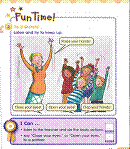 |
Lesley Ito
Originally from Florida, Lesley Ito has been involved with ELT in Japan for 18 years. She is the owner of BIG BOW English Lab in Nagoya, the author of the WE CAN! Teacher's Guides and has made numerous teacher training presentations all over Japan, from Hokkaido to Kyushu. She has also written numerous articles on teaching young learners and is active in teaching organizations in Japan. Currently she is the Program Director of JALT Junior and the
Program Chair of the TC SIG.
|
 |
|
 |
Fun with the WE CAN!
【No. 7: Goal Checking】
Also Sharing ideas by Rikaco Miyoshi, English Studio KIKI, Osaka
*Book1 Unit2 (My Body page 13) |
 |
 I really enjoy going to teaching events because I always come up with new ideas after talking with my fellow teachers. In fact, I came up with this year’s theme for my Teaching Tips blog at last year’s Kansai ETJ EXPO after making a We Can! presentation about using props in the classroom. My friend Rikaco was telling me a fun way she checks one of the Goals in We Can! and after talking with her, I thought it would be a great idea if I could share easy-to-use ideas on using We Can!, from my classroom and also from other teachers using We Can! So, please submit your favorite game, activity or idea on using We Can! to info@wecanenglish.jp The best ideas will be spotlighted in the Teaching Tips blog and the teacher will win a pair of Kai and Eva puppet. I can’t wait to hear everyone’s ideas! I really enjoy going to teaching events because I always come up with new ideas after talking with my fellow teachers. In fact, I came up with this year’s theme for my Teaching Tips blog at last year’s Kansai ETJ EXPO after making a We Can! presentation about using props in the classroom. My friend Rikaco was telling me a fun way she checks one of the Goals in We Can! and after talking with her, I thought it would be a great idea if I could share easy-to-use ideas on using We Can!, from my classroom and also from other teachers using We Can! So, please submit your favorite game, activity or idea on using We Can! to info@wecanenglish.jp The best ideas will be spotlighted in the Teaching Tips blog and the teacher will win a pair of Kai and Eva puppet. I can’t wait to hear everyone’s ideas! |
 |
 Rikaco Miyoshi (三好里加子) is the owner of English Studio KIKI (イングリッシュ・スタジオ KIKI) in Osaka. She is well known for performing English rakugo at the Kansai ETJ EXPO. She said that she often finds it very effective to get the students to pretend they are in a situation and then use English in that imaginary situation, instead of just telling them what to say. She used this principle to great effect to check Goal 10 in We Can! Level 1, Unit 2 (My Body, page 13). She told the class that they were going to hypnotize each other (“SAIMIN JUTSU” in Japanese) and then divided the class into two groups. The group she was in told the other group, “We are magicians with magic powers. We will hypnotize you!” Then her group told the other group, “Close your eyes,” or “Open your eyes,” while they moved their hands as if they were trying to hypnotize the other students. The students being “hypnotized” would obey the commands of the “magicians”. After the “magicians” checked Goal box 10 in their books, the groups switched roles and they did the activity again. I thought this was an excellent example of using children’s strengths, in this case the ability to pretend, to add excitement to the learning process. This “hypnosis” activity could be used to check many goals where one student has to tell the other to do something. In Level 1, this would work well with Goal 12, Goal 14, Goal 36 or Goal 45. Rikaco Miyoshi (三好里加子) is the owner of English Studio KIKI (イングリッシュ・スタジオ KIKI) in Osaka. She is well known for performing English rakugo at the Kansai ETJ EXPO. She said that she often finds it very effective to get the students to pretend they are in a situation and then use English in that imaginary situation, instead of just telling them what to say. She used this principle to great effect to check Goal 10 in We Can! Level 1, Unit 2 (My Body, page 13). She told the class that they were going to hypnotize each other (“SAIMIN JUTSU” in Japanese) and then divided the class into two groups. The group she was in told the other group, “We are magicians with magic powers. We will hypnotize you!” Then her group told the other group, “Close your eyes,” or “Open your eyes,” while they moved their hands as if they were trying to hypnotize the other students. The students being “hypnotized” would obey the commands of the “magicians”. After the “magicians” checked Goal box 10 in their books, the groups switched roles and they did the activity again. I thought this was an excellent example of using children’s strengths, in this case the ability to pretend, to add excitement to the learning process. This “hypnosis” activity could be used to check many goals where one student has to tell the other to do something. In Level 1, this would work well with Goal 12, Goal 14, Goal 36 or Goal 45. |
 |
| Goal checking is such an important part of We Can! and goals are a positive way to assess students’ steadily increasing improvement. With goals, the focus is on what the student can do. With a test, most people focus on what mistakes were made. It is also important that teachers check the goals in a consistent manner and praise students when they receive that check in the Goal box because students who receive praise that they have genuinely earned are more likely to become confident speakers of English. |
 |
In the We Can Teacher’s Guide, there are suggestions on how to check goals in a time efficient manner. Mostly, these take the form of:
| 1. |
Asking the students to stand in a line in front of the teacher. When the reach the teacher, they have to demonstrate they can do what the goal asks of them. Then the teacher checks the Goal box in the student’s book. |
| 2. |
Having the students make pairs. The student has to demonstrate to their partner that they can do what the goal asks of them. Then the partner checks the Goal box in the book. |
| 3. |
Having the students stand up and demonstrate as a class (in a small class) or in groups (in a larger class) that they can do what the goal asks of them. Then the students can check the Goal box in their own books. |
|
 |
| In an environment where children do not need to use English, it is easy for them to lose the motivation to study after a while or to not feel as if they are making progress. Completing and checking the goals class by class can really help eliminate this problem! |
|



